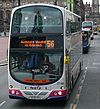History
Originally this was on the grounds of house of John Glassford; a noted Tobacco Lord. The street was opened in 1793 and originally named Great Glassford Street. Glassford's house, known as the Shawfield Mansion, [1] was removed in 1792 to build the street. [2]
At the time of its opening the street now known as South Frederick Street, to the south of George Square, was known as Little Glassford Street; hence the original Great Glassford Street differentiation. Great Glassford Street was still being used in an advertisement of 1802. [2]
As the new name of South Frederick Street became known instead of Little Glassford Street, there was no need for the differentiation of Great Glassford Street. The street simply became known as Glassford Street. [2]
This page is based on this
Wikipedia article Text is available under the
CC BY-SA 4.0 license; additional terms may apply.
Images, videos and audio are available under their respective licenses.



